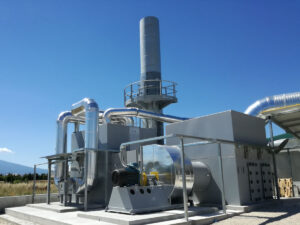- The environmental impact of naval painting processes.
- Emissions characteristics
- Depuration goals
- The solution through the process of rotoconcentration and regenerative thermal oxidation.
- The measures identified for application in the naval painting industry.
- The results achieved
- Go to the gallery with all our systems
VOCs emission control systems for painting process in naval industry
For worldwide services in the construction of large ships, Brofind® has implemented an abatement plant for effluents resulting from the painting department. The naval industry production cycle includes substantial operations of surface treatment of ferrous materials that are subjected to pre-treatments and treatments to improve their resistance in aggressive environmental conditions, such as those of the marine environment.
The application of paints on ferrous materials takes place in closed, large rooms, using solvent-based products, which are released into the work environment and extracted from special ventilation systems both during the application phase and during the subsequent one of drying or withering; emissions into the atmosphere therefore contain Volatile Organic Compounds (V.O.C.) and dust generated by the paint fractions (overspray) that failed to settle on the part to be painted and which can be emitted into the surrounding environment generating olfactory nuisance and environmental pollution.
Emissions characteristics
Atmospheric emissions deriving from naval painting processes have the following characteristics:
| VARIABLE | CHARACTERISTICS |
|---|---|
| Temperature | Room |
| Presence of volatile organic compounds (V.O.C.) | Aromatic hydrocarbons and alcohols |
| Flow rates of emitted air | Very high, given the need for ventilation of very large rooms |
| Presence of organic dusts | Consequence of the overspray produced during the paint application process |
| Humidity | Room |
| Operational cycle | On several daily shifts, alternating application and drying phases |
| Variability | High, depending on the simultaneous application and drying phase on several painting rooms |
Depuration goals
The purpose of purification is mainly to minimize the emission into the atmosphere of those pollutants harmful for the environment (VOC), in compliance with the regulatory limits set for each pollutant individually, minimizing the formation of secondary pollutants and with costs investment and management acceptable for the production process.
The solution through the process of rotoconcentration and regenerative thermal oxidation.
To solve the environmental problem, characterized by emissions with very high air flow characteristics and low concentrations of pollutants, but in quantities higher than those imposed by the regulatory limits, it was necessary to combine the application of two technologies.
The first one consists of roto-concentration, which allows the pollutant present in a high air flow rate to be transferred into a second, much smaller air flow rate; in this way it is possible to purify the main emission, generating a second emission that will have higher pollutant concentrations. The transfer of the pollutant from the initial to the concentrated emission takes place using an adsorbent material, which can retain the pollutant and release it if suitably heated.
The concentrated emission will be intended for a further treatment phase which, through a second technology, will allow the final purification of the emission: in the latter case, the regenerative thermal oxidation technology has proved to be particularly effective.
Regenerative thermal oxidation is a process that allows, in the presence of high temperatures and the oxygen normally contained in the emissions, the transformation of organic pollutants into by-products with a reduced environmental impact: water and carbon dioxide. Poiché per far avvenire la reazione di conversione è necessario innalzare la temperatura dell’emissione. Since for the conversion reaction to take place it is necessary to raise the temperature of the emission up to 800-900°C, a particularly efficient energy recovery is foreseen. Thanks to the use of specific ceramic filling bodies, it is possible to significantly contain the operating costs related to the use of auxiliary fuel that feeds a special burner.
Rotoconcentration is a process frequently used for the treatment of atmospheric emissions containing vocs released in industrial painting processes, characterized by the need to treat high air flows and reduced quantities of pollutants; it is not a final treatment, for which it must be combined with another technology: in this case, it has been combined with regenerative thermal oxidation, which completes the purification of the concentrated emission.
The application in the naval industry had to foresee the identification and application of specific measures aimed at enabling the following goals:
- The achievement of the highest purification performances, through a specific sizing of the process parameters.
- The optimization of energy consumption, thanks to the combination of multiple technologies, aimed at allowing the treatment of high air flow rates with reduced quantities of pollutants.
- The ability to resist any dirtying and clogging phenomena caused by the presence, in the emission, of organic dusts resulting from the overspray produced in the painting process.
- Plant durability over time, through the use of resistant materials and components in the presence of marine environments.
The results achieved
The results obtained thanks to the combination of these technologies confirms the efficiency of the solution that has allowed us to achieve the following goals:
- The disappearance of olfactory harassment and the consequent effects on the surrounding environment.
- The achievement of concentration values of pollutants emitted into the atmosphere significantly lower than the prescribed regulatory limits.
- The reduction of the formation of secondary pollutants.
- The containment of management costs.
- No interference with the production processes upstream of the purification plant.

